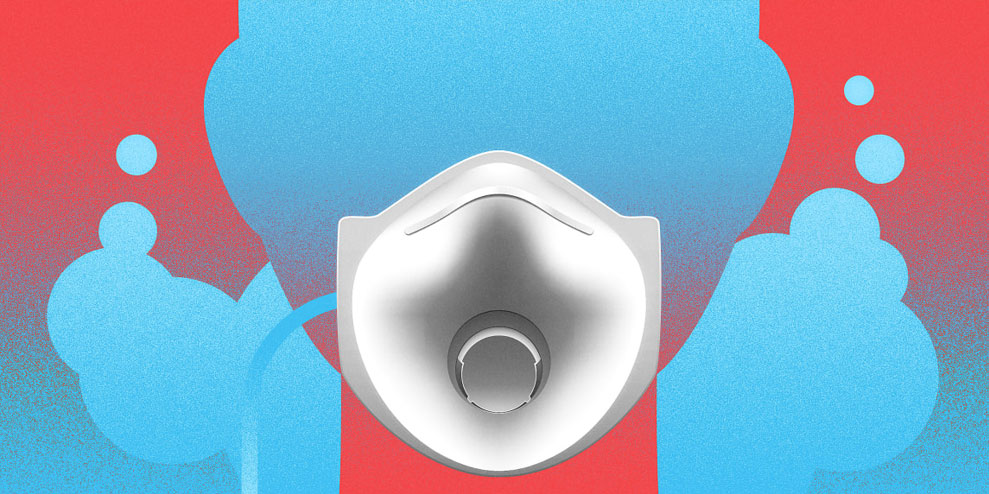It’s hard to breathe in an N95 mask. This Stanford scientist has a clever solution.
It certainly doesn’t look elegant: an N95 mask, with two tubes sticking out, one of which snakes its way down to a bolted hunk of metal that resembles an industrial Discman. But looks can be deceiving. This new device, being developed at Stanford, is probably the most comfortable N95 a nurse or doctor could ever wear.
How the heck is that possible?
“It’s basically an air conditioner for an N95 mask,” says John Xu, the research scientist leading the project.
N95 masks are the gold standard for medical workers treating COVID-19. When worn correctly, they can filter 95% of airborne particles, unlike surgical masks, which are not designed to filter pathogens. But N95 masks are hot and humid on the face. Worse still, early research has found that when you wear an N95, you actually breathe in 5% to 20% less oxygen than normal unfiltered air, and higher proportions of the CO2 you exhale. One study found that healthy people can adapt to this difference, and over an hour of wear, their blood oxygen and CO2 levels were no different than they would be normally—perhaps because they simply take longer, deeper breaths.
Even if oxygen levels aren’t a pressing physiological problem, they still pose a human factors issue that makes N95 masks less protective than they should be. Xu suggests the lack of oxygen and surplus of CO2 is uncomfortable by nature, which might lead you to adjust your mask often, touching your face more than you should. Or you might even unconsciously break the mask’s own air-tight seal to your face to feel relief.
Xu’s device is built to make the sensation of wearing an N95 for an extended period of time less stuffy—important for nurses and doctors wearing them for hours on end in the field. His solution has been knocking around in the back of his mind for the past three years, ever since he saw California ravaged by wildfires. What if he could create a device that actually created oxygen, and that oxygen could be pumped into a mask to make it more comfortable?
N95 masks provide important protection against the coronavirus, but they also make it harder to breathe. Stanford mechanical engineers John Xu and Fritz Prinz are working on a solution using technology designed for fuel cell cars: https://t.co/iUx7Hk40gT pic.twitter.com/ioEnXBfYX7
— Stanford University (@Stanford) April 16, 2020
Xu’s primary research is in developing hydrogen fuel cells, like those proposed for clean-running cars, which leak water vapor from their tail pipes and nothing else. “We normally create fuel cells by combining hydrogen and oxygen, to [output]water,” Xu says. But as COVID-19 began spreading across the globe, he started thinking about his own idea of fixing the N95 mask again. The reverse process used by a fuel cell is electrolysis. That would allow him to start with water, add a bit of electricity, and create perfectly clean oxygen (and if you’re counting molecules, the excess hydrogen is actually recaptured to create more electricity).
What he has developed at Stanford is a working prototype that does just that. It’s a waist-mounted machine that plugs into any stock N95 mask to upgrade it. The machine is filled with water. Requiring only about four times the electricity of your average smartphone, the battery can be charged to turn water into pure oxygen that can flow right into an N95 mask. Meanwhile, that second tube in the mask sucks away CO2. So in theory, someone wearing Xu’s invention breathes in a mix of gases that more closely resembles good old normal air. The only reason a mask would feel uncomfortable is the physical sensation of having it tight against one’s skin.
Hasn’t this idea been done before? PAPR is an N95 alternative that places a big helmet on someone’s head, then pumps in air for them to breathe. Xu agrees that PAPR is a similar idea, but he points out that PAPR uses a fan to suck in air from around the wearer. This fan creates distracting noise. And while its air is filtered with a HEPA filter, that’s still not a foolproof filter. His device creates pure oxygen from water itself. There’s no possible contaminant in this feed. And using a stock N95 instead of specialized headgear should be more comfortable, and more accessible to most healthcare specialists. Finally, he imagines this base unit could be sold for $300 versus the ~$1,000 price of a PAPR system.
So what’s next for Xu’s project? He points to two milestones that his lab needs to prove out before moving forward. First, they need to figure out the right oxygen ratio to pump into the N95, and prove that this really does increase wearer comfort. Secondly, they need to finalize form factor of the gadget—particularly, exactly how much battery power it will need to run for a six-hour shift.
And then? Xu speaks elusively about the next phase that will come once these two milestones are met. He won’t commit to production plans of a commercial device during the COVID-19 pandemic, but he also doesn’t shoot down the possibility either.
“It’s not that we don’t want to comment, but things are moving pretty slow in our country. Even if we work very hard, some of the suppliers and parts need to be shipped from other parts of the world where there have been delays,” Xu says. “We really hope some of the research inside the university can have a positive impact.”
–
This article first appeared in www.fastcompany.com
Seeking to build and grow your brand using the force of consumer insight, strategic foresight, creative disruption and technology prowess? Talk to us at +971 50 6254340 or mail: engage@groupisd.com or visit www.groupisd.com/story

